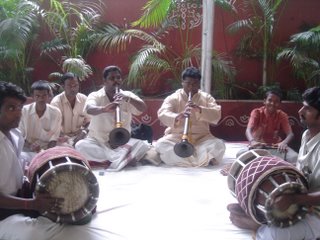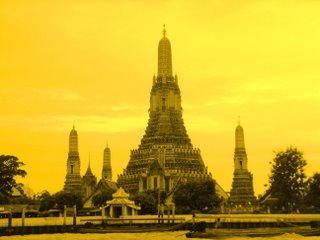Yesterday I had an opportunity to participate in an Indian thread ceremony for a colleague’s son. This ceremony is a rite of passage similar to a confirmation, or bar mitzvah in the Hindu context. Every intricate detail had rich meaning and to be apart of the experience was amazing.

Background info on Upanayanam (Thread Ceremony)
Upanayanam is the
Samskara or the ceremonial rite in which the young Brahmin boy is invested with the sacred thread and initiated into the
Gayatri - the Holiest of all
mantras in the legacy of the
Rishis. This ceremony is only for boys from the top three social classes. Traditionally, an auspicious time and date is chosen to shave the boy's head completely, leaving only a small tuft in the centre of the scalp, called bodi.
The sacred thread used for the ceremony consists of three strands, joined by a knot known as Brahmagranthi or the knot of Brahma. The three strands symbolise the Hindu trinity -
Shiva,
Vishnu and
Brahma. There are various interpretations of the three strands to represent many of the other triads like Mahasarasvati, Mahalakshmi and Mahakali. Or the three qualities known as
sattva,
rajas and
tamas; past, present and the future; the three states - wakefulness, dream and deep sleep. Some even say that it represents the three dimensions known as heaven (swarga), earth (martyaloka) and netherworld (patala). The twist of the thread must be upwards to ensure that the Sattwaguna or the good quality of truth predomin

ates.
The most important meaning of the three strands is ida, pingala and susumna nadi, through which the
kundalini energy manifests as
prana and consciousness. Yajno-pavita means 'thread of sacrifice.' That is so called because it symbolises the sacrifice of
ego.
The sacred thread was a passport to obtain
education. It was a prerequisite for education and also for
marriage. Without it, no man could dream of getting a
bride for himself. It was considered important because a person with Yajnopavita should have undergone all the oaths associated with wearing it, led a
celibate life and completed a major portion of his education. Brahmachari or the bachelor (also, a learner) wore a single sacred thread while the householder or the married person wore two. A person who was married and had lost one or both of his parents wore three.
There are different methods of wearing the Sacred Thread at different occasions. While performing an auspicious ceremony one should be Upaviti, that is, the Sacred Thread should hang from his left shoulder. At the performance of some inauspicious ceremony one should be Prachnaviti, that is, the Sacred Thread should hang from the right shoulder; and at times he is called Niviti when the Sacred Thread is worn round the neck like a garland.
This ceremony has evolved over time and to see more of my experience you can check out the links to my pics and videos
 roads ever since its inception in 1948. Ambassador, the only automobile to ply Indian roads for more than five decades now, has carved a special niche for itself in the passenger car segment. It's dependability, spaciousness and comfort factor have made it the most preferred car for generations of Indians. The Ambassador's time-tested, tough, accommodating and practical characteristics make it a truly Indianised car. "
roads ever since its inception in 1948. Ambassador, the only automobile to ply Indian roads for more than five decades now, has carved a special niche for itself in the passenger car segment. It's dependability, spaciousness and comfort factor have made it the most preferred car for generations of Indians. The Ambassador's time-tested, tough, accommodating and practical characteristics make it a truly Indianised car. "















